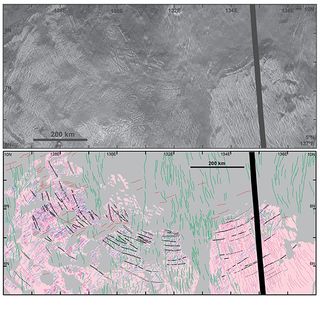1 Min Read Oral History with Stephen G. Jurczyk, 1962 – 2023 NASA Acting Administrator Stephen G. Jurczyk Credits: NASA Steve Jurczyk’s NASA career began in 1988 at Langley Research Center as an engineer in the Electronic Systems Branch. During his time at Langley, he served in other roles, including director of engineering and director of research and technology. Jurczyk was named as director of Langley in 2014, then in 2015 he left Langley to serve as the associate administrator for the Space Technology Mission Directorate at NASA Headquarters. He…
Read MoreDay: November 7, 2024
Russia sends 53 satellites to orbit on record-breaking launch (video)
Russia launched 53 small satellites into orbit on Monday (Nov. 4), a mix of Russian and international spacecraft. A Soyuz-2.1b carrier rocket with a Fregat upper stage lifted off from the Vostochny spaceport in the Russian Far East at 6:18 p.m. EST on Monday (2318 GMT; or 2:18 a.m. on Nov. 5 local time). “The hosted payload consisting of 49 Russian satellites, a Russian-Chinese satellite, a Russian-Zimbabwean satellite and two Iranian small satellites was delivered into the designated orbits and separated from the Fregat booster that was launched by a…
Read MoreOral History with Mary L. Cleave, 1947 – 2023
1 Min Read Oral History with Mary L. Cleave, 1947 – 2023 61B-21-008 (26 Nov-1 Dec 1985) —The STS 61-B crew on the flight deck of the earth-orbiting Atlantis. Left to right, back row, are astronauts Jerry L. Ross, Brewster Shaw Jr., Mary L. Cleave, and Bryan D. O'Connor; and payload specialist Rodolfo Neri. Front row, left to right, payload specialist Charles D. Walker and astronaut Sherwood C. Spring. A veteran of two space flights, Dr. Cleave served as a mission specialist on STS-61B and STS-30. She went on to…
Read MoreThe Cast and Crew of “Ain’t Too Proud” Visit NASA Langley
1 min read Preparations for Next Moonwalk Simulations Underway (and Underwater) Members of the cast and crew of “Ain’t Too Proud – The Life and Times of the Temptations” pose for a photo inside of the 8-foot high-temperature tunnel at NASA’s Langley Research Center in Hampton, Virginia. NASA/David C. Bowman Get Ready! Members of the cast and crew of the Broadway national touring production of “Ain’t Too Proud – The Life and Times of The Temptations,” visited NASA’s Langley Research Center in Hampton, Virginia on Nov. 6, where they learned…
Read MoreEarth Below
As the International Space Station soared 257 miles above northern Mexico, NASA astronaut and Expedition 72 flight engineer Don Pettit captured this long-exposure photograph of city lights streaking across Earth while a green atmospheric glow crowned the horizon.
Read MoreHurricane Helene’s Gravity Waves Revealed by NASA’s AWE
2 min read Hurricane Helene’s Gravity Waves Revealed by NASA’s AWE On Sept. 26, 2024, Hurricane Helene slammed into the Gulf Coast of Florida, inducing storm surges and widespread impacts on communities in its path. At the same time, NASA’s Atmospheric Waves Experiment, or AWE, recorded enormous swells in the atmosphere that the hurricane produced roughly 55 miles above the ground. Such information helps us better understand how terrestrial weather can affect space weather, part of the research NASA does to understand how our space environment can disrupt satellites, communication…
Read MoreStudent-Built Capsules Endure Heat of Re-entry for NASA Science
4 Min Read Student-Built Capsules Endure Heat of Re-entry for NASA Science The five capsules of the KREPE-2 mission are pictured on Earth prior to flight. Credits: University of Kentucky. In July 2024, five student-built capsules endured the scorching heat of re-entry through Earth’s atmosphere as part of the second Kentucky Re-Entry Probe Experiment (KREPE-2). Scientists are now analyzing the data from the KREPE-2 experiments, which could advance the development of heat shields that protect spacecraft when they return to Earth. The mission was designed to put a variety of…
Read MoreAttention Students: NASA Launches Power Systems Student Essay Contest
Twelve-year-old, Aadya Karthik of Seattle, Washington; nine-year-old, Rainie Lin of Lexington, Kentucky; and eighteen-year-old, Thomas Lui, winners of the 2023-2024 Power to Explore Student Writing Challenge observe testing at a NASA Glenn cleanroom during their prize trip to Cleveland. Credit: NASA NASA’s fourth annual Power to Explore Student Challenge kicked off November 7, 2024. The science, engineering, technology, and mathematics (STEM) writing challenge invites kindergarten through 12th grade students in the United States to learn about radioisotope power systems, a type of nuclear battery integral to many of NASA’s far-reaching…
Read MoreVenus’ ‘missing’ giant impact craters may be hiding in plain sight
Impact features on Venus may have been staring us in the face all along That’s the message from a team of planetary scientists, who have explained Venus‘ apparent dearth of large craters by discovering that impacts could have produced the mysterious “tesserae” formations on the Venusian surface. Tesserae are large — sometimes continent-size — expanses of terrain that have been deformed and covered with wrinkle ridges, which make the landforms look like sheets of corrugated iron. They are formed by lava welling up to the surface, where it cools and…
Read More





